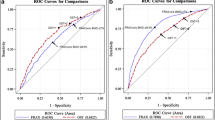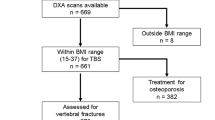Summary
With stepwise multiple logistic regression (MLR), probabilistic classification equations were developed to identify asymptomatic women who are at risk for development of fracture of the spine. Clinically normal women with low TBCa/\(\sqrt H \) ratios can be classified as at risk for osteoporosis prior to their developing spinal compression fractures. With receiver operating characteristic (ROC) analysis, it was possible to verify the accuracy of the MLR model to discriminate “normal” women at risk, with high sensitivity and specificity. With the MLR model, discrimination of osteoporotic women (50–59 years) was made correctly for 86.2% of the total osteoporotic subjects with the TBCa data. Similar models were derived from the photon absorptiometry data. From the spinal density (BDs) data, correct classification in the 50–59 year group was 55.6% of the total osteoporosis subjects; from the radius density (BMCr) data, the corresponding value was 31%. The highest probability of identifying osteoporosis in all age categories was, therefore, on the basis of TBCa data. Similar, but less accurate discrimination was achieved with the BDs and BMCr data. These conclusions were confirmed by the application of receiver operating characteristic (ROC) analysis. Correct identification of the population at risk permits the timely and efficient application of therapeutic programs prior to onset of fracture. In a serial study of 104 perimenopausal women, for example, it was possible to determine theP value for individuals measured annually over a 3–10 year period and thus to predict normal individuals at risk for developing osteoporosis each year.
Similar content being viewed by others
References
Osteoporosis NIH Consensus Development Conference Statement. Vol. 5, No. 3, 1984
Cohn SH, Ellis KJ, Wallach S, Zanzi I, Atkins HL, Aloia JF (1974) Absolute and relative deficit in total skeletal calcium and radial bone mineral content in osteoporosis. J Nucl Med 15:428
Cohn SH, Vaswani AN, Zanzi I, Ellis KJ (1976) Effect of aging on bone mass in adult women. Am J Physiol 230:143
Cohn SH, Zanzi I, Vaswani AN, Wallach S, Aloia JF, Ellis KJ (1976) Quantitation of the degree of osteoporosis by measure of total body calcium. Calcif Tissue Res 21:375
Cohn SH, ed (1981). Non-invasive measurements of bone mass and their clinical application. CRC Press, Boca Raton, Florida, p 222
Lee J (1980) Covariance adjustment of rates based on the multiple logistic regression model. J Chron Dis 34:415
McNeill BJ, Adelstein SJ (1976) Determining the value of diagnostic and screening tests. J Nucl Med 17:439
Metz CE (1978) Basic principles of ROC analysis. Semin Nucl Med 8:283
Jensen GF, Christiansen C, Boesin J, Hegedus V, Transbol I (1982) Epidemiology of postmenopausal spinal and long bone fractures, Clin Orthop 166:75
Ott SM, Murano R, Lewellen TK, Nelp WP, Chesnut III CH (1983) Total body calcium by neutron activation analysis in normals and osteoporotic populations: a discriminator of significant bone loss. J Lab Clin Med 102:637
Cohn SH (1982) Techniques for determining the efficacy of treatment of osteoporosis. (Editorial) Int J Calcif Tissue 34:433
Cohn SH, Aloia JF, Yuen K, Vaswani AN (1984) Comparison of cross-sectional and longitudinal models of bone loss in women. XVIII Europ Symp on Calcif Tissue, Angers, France.
Riggs BL, Wahner HW, Dunn WL, Mazess RB, Offord KP, Melton LJ (1981) Differential changes in bone mineral density of the appendicular skeleton and axial skeleton with aging: relationship to spinal osteoporosis. J Clin Invest 67:328
Mazess RB, Peppler WW, Chesney RW, Lange TA, Lindgren U, Smith Jr E (1984) Total body and regional bone mineral by dual-photon absorptiometry in metabolic bone disease. Calcif Tissue Int 36:8
Author information
Authors and Affiliations
Rights and permissions
About this article
Cite this article
Cohn, S.H., Aloia, J.F., Vaswani, A.N. et al. Women at risk for developing osteoporosis: Determination by total body neutron activation analysis and photon absorptiometry. Calcif Tissue Int 38, 9–15 (1986). https://doi.org/10.1007/BF02556588
Received:
Revised:
Issue Date:
DOI: https://doi.org/10.1007/BF02556588




